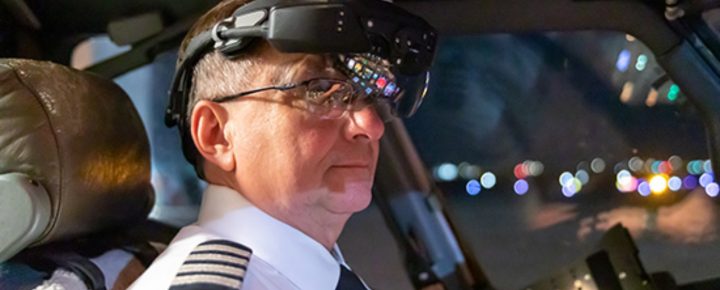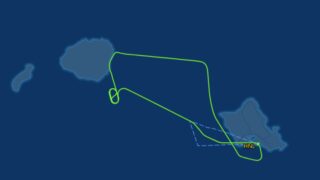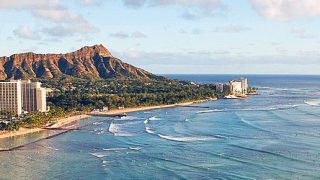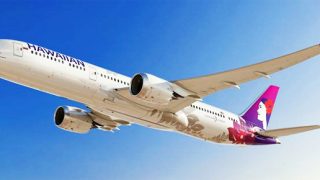Last week, the FAA approved a new virtual reality (VR) headset for airline pilots that is poignant today given the Japan Airlines runway incursion crash and should prove helpful in the safety and future of aviation. You will understand why if you see your next flight to Hawaii pilot donning one of these.
Pilot goggles for Virtual Reality (VR) are special headsets that immerse pilots in a realistic virtual environment. They consist of a comfortable head-mounted display with high-quality lenses and sensors. Pilots wear these to experience improved visualization of real-time conditions. These goggles have largely been a tool for pilot training, and will now make their way to the cockpits of flights to Hawaii and elsewhere.
The global augmented Reality (AR) and Virtual Reality (VR) market is growing exponentially. In aviation, what was a one billion dollar a year market recently, is expected to grow to more than twenty times that size by the end of this decade, underscoring its ever-expanding application air travel.
AR, overlays digital information onto a user’s real-world view, providing an enriched perception of the environment. In aviation, AR may become invaluable in providing pilots with improved real-time information about their plane’s surroundings, including weather, terrain and other aircraft. This may enhance navigation and safety significantly.
This FAA approval followed last year’s announcement that the company, AerSale, has awarded Universal Avionics a new $33 million contract to supply wearable enhanced flight vision system (EFVS) for Boeing 737NG aircraft. Boeing 737 NG aircraft include those still flown by Alaska Airlines and United on Hawaii flights.
AerSale worked on the Boeing 737 program “After previously working to develop its “SkyLens wearable Head-Up Display (HUD) on the Airbus A320. Under the contract, Universal will supply its SkyLens™ Head Wearable Display (HWD) and EVS-5000 cameras to AerSale to distribute the system to airlines as “AerAware.” We can only assume that this will expand to other fleets in the very near future.


Universal’s 3D “vision.”
The system “features six sensors and what’s termed their 3D Synthetic Vision System (SVS). Universal says that the system overcomes “extreme weather conditions and low visibility situations both day and night with intuitive out-of-the-window flying provided by the ClearVision Enhanced Flight Vision System.”
The contract will ensure their ability to deliver the AerAware system to “the growing number of airlines who have expressed interest in this solution. We are bringing this innovative solution to commercial operators for improved safety and operational effectiveness and we’re seeing a lot of excitement as we conduct demonstration flight tests.
Nicolas Finazzo, Chairman and CEO of AerSale
Head-worn displays are still new to US airlines.
The company said it offers what is described as “Real-time aircraft systems data, advanced multispectral camera imaging, and synthetic vision onto a Head Wearable Display (HWD).
Providing pilots with visual approach and landing assistance.
The wearable display can offer pilots the “required visual approach and landing references earlier in the airport landing approach process.”
Would something like this have made a difference on the JAL Airlines plane that crashed earlier today? No.
We certainly don’t think so, but we would love to have more input from pilots and others about that and about VR. One airline pilot friend we asked said he wasn’t that familiar with the VR goggle system but was certainly curious to learn more.
FAA approval was required.
While such head-worn displays (HWD) have been found on military aircraft for some time, currently, no U.S.-registered airline operates with HWDs.
“With additional technology advances, such displays may be able to qualify under 14 CFR § 91.176 as an ‘equivalent display’ and thereby achieve full EFVS status,” said the FAA.
The manufacturer said that this “Brings substantial capabilities to the 737NG and has demonstrated its advantages to operations, including the ability to overcome degraded visibility solutions during any time of day. I believe that the ability to allow aircraft to operate in conditions well below published minimums is a game-changer.”
Aircraft modifications per type for VR to work.
Part of the complexity of such systems is that they require approved aircraft modifications to operate. In the case of the 737NG, those required to enable AerAware include a new radome to accommodate the camera installation, system wiring, connectors, and mounting hardware in equipment bays and flight deck. AerSale will now be able to provide the certified AerAware system to commercial airlines operating 737NG aircraft as well as A320 planes.







Rich…aviation accident inquiries are typically void of political interference to improve the safety of the system. Its called “Just Culture”. Any inquiry information being release at this time is all through media and not official, sensationalized to sell copy.
Fuel + Ignition = Fireball
“Parked” 28,000lb DH8-300 carrying 800 USG fuel being struck at 145kts (166mph or 270kmph) by a 330,000lb A350-900 carrying, at minimum, 3000 USG fuel = Fireball (initial ball was surely the fuel from the DH8 tanks).
Concorde: A piece of metal picked up by the left main gearset piercing #6 fuel tank carrying 3900 USG fuel then spilling into exhaust outlets of # 1+2 engine and igniting = Fireball.
All true. My point about political bias relates to previous accidents with Airbus in Europe and Boeing incidents in USA. There does not need to be any such bias for rumors to circulate. My point is Japan has no interest in either firm so their report is less likely to provoke speculation. As I previously posted, I have concerns not an opinion and I await the report. My concern stems the pilots saying there was no indication of the on board fire extinguisher having activated. This does not mean they did not activate. So we wait for the facts. One fact that has come out that I had not previously heard is that carbon fiber in modern equipment presents a hazard to fire crews when it burns leaving hazardous particles in the air.
Totally agree Don K (cool name) people seem to think, somehow, that aircraft are tanks. They are very delicate pieces of equipmemt and even the slightest out of the normal operation can damage them to a “writeoff” condition.
This aircraft performed exceptionally well, it absorbed running into a 28,000lb brick on the runway, absorbed all the resultant energy in the airframe, and through the training of the crew and dicipline of the passengers, spared everyones life without major injury. Kudos to Airbus “Bravo Zulu”!!
Oh, and “No 1 for takeoff” is common most everywhere btw, not just Japan. Especially in that particular departure sequence situation at that time. Thats not going away.
Reports coming from Japan now say the flight deck are stating all the systems in the cockpit failed on the A350 following the collision so they could not steer or brake neither could they communicate with the flight attendants. So a vr headset would have failed too. I think we will hear more about the A350 issues.
The headset would be used to prevent the accident in the first place. Also, its a set of visual aids, more like goggles, its not a headset that carries communication, so has nothing to do with it.
In a crash like that, there is no need for communication from cockpit to cabin, everybody knows their job. Flight attenants don’t need to wait for words from the pilots, they just react as trained.
I quoted from the pilots’ evidence at the japanese inquiry. It concerns me that everything in the cockpit failed on collision. The JAL procedure was the Captain instructs evacuation. Apart from losing communication with anyone, total lack of control of the aircraft and no indication that the onboard fire extinguishers for the engines had been deployed, I believe there needs to be a thorough investigation of this equipment. I was at Haneda when it happened and the fireball was enormous. The Japanese employed many many fire engines to stop the engine flames which appeared to die down then a fire broke out in the cabin. You obviously understand the issues in more detail, are you type approved for the A350?
I am an ATP pilot, a 30year air traffic controller (Radar and Tower) and have a good friend who is an airbus 330 Capt and sumulator instructor and a buddy who is B777 Capt. Im well versed in the industry on both sides. There is a lot of false info in the news from a lot of people who think they know, as always is.
I agree which is why I quoted the evidence of the pilots involved rather than the journalists. I think the plan to remove “No 1 for take off” from Japanese ATC is a positive step to increase clarity. My Commercial friends are mostly Boeing. The VR headsets could be very helpful in certain circumstances for example the airports on Lanai and Molokai. I was taught though that being aware of all traffic involves continually scanning with your eyes, particularly in Hawaii where mixed traffic is common. Thanks for your input.
You really answered to your own response with the line “The fireball was enormous”! What did you think would happen when the aircraft erupted into a fireball!? The nose gear was gone as they careened down the runway and there was fire everywhere and you expected all of the onboard systems to remain functional!? It is not Star trek where they could switch over to auxiliary power because at that moment in time the flight crew were nothing but passengers too!
I am concerned in the same way I was concerned about the fire on the Concorde crash. I do not think the guesses or opinions of posters here are more than that and I will wait fir the result of the Japanese inquiry which looks very professional with zero political intervention.
The LAST thing needed in our cockpits is to “immerse pilots in a realistic virtual environment …” AerSale ($$$ is even in their name) is about making money, the FAA is frequently (usually?) playing catch-up, and airline managements are usually clueless on operational matters.
What “we” REALLY need is for more situational awareness from disciplined application of time-tested methods of keeping your head on a swivel, eyes out of the cockpit, paying attention to comms, and keeping unnecessary distractions to an absolute minimum.
IMO, the more we go to technology in flying airplanes and the less we rely on the basics — what really works — the more accidents/incidents we will see … 27K+ flight hours here.
Haneda? Q.E.D.
At Haneda on way back from Kauai. Very glad everyone escaped the A350, JAL is a superb carrier. Very sad that 5 people died on Coast Guard flight. NHK is reporting the Coastguard did not comply with instruction to hold short on 5C and entered the runway at the last minute. Do not think a headset would help instructions are not followed. There was a similar event at LAX many years ago but then landing plane did not turn into an inferno. What worries most is the fire that engulfed the new a350. Last time i saw footage like that was the Concorde crash.
If they could implement something like tcas so that any attempt to enter a live runway when told to hold or enter final without confirmation would force preventive action in the aircraft.
LAX incident being somewhat similar, but in that case the smaller departing aircraft was on the runway waiting to depart, no chance. This time the smaller aircraft entered the runway, so could have looked before entering, or have been told of the pending arrival threat.
There was no time for even an automated system to react in this case. Hold lines are 200 feet back from runway edge, some large aircraft wingtips exceed runway edge, especially in US with only 180ft wide runways.
We already have stop bars (big red lights across the runway edge) but they need to be turned on and adhered to.
It breaks down to humans are involved, and there will be situations
Agree with Don W and Rich…I believe these are basically wearable Heads Up Displays that would only be worn when visibility is very low. The technology to arm the TCAS on the active runway would be key but still an issue if the pilot doesn’t arm it when taxing on to the runway. It’s still a human function. Alaska has led the industry in RNP approaches and using HUD…greatly enhanced safety in very low visibility situations. Rarely needed in Hawaii.
As long as the systems cannot be corrupted in any way as to the information presented to the flight crew while they are being worn then I have no issue with them wearing such a device if it actually does improve airline flight safety. Unfortunately as we have seen fairly regularly supposedly secure systems have proven to be anything but secure. In other words, who will hold the keys to the security systems of the devices?